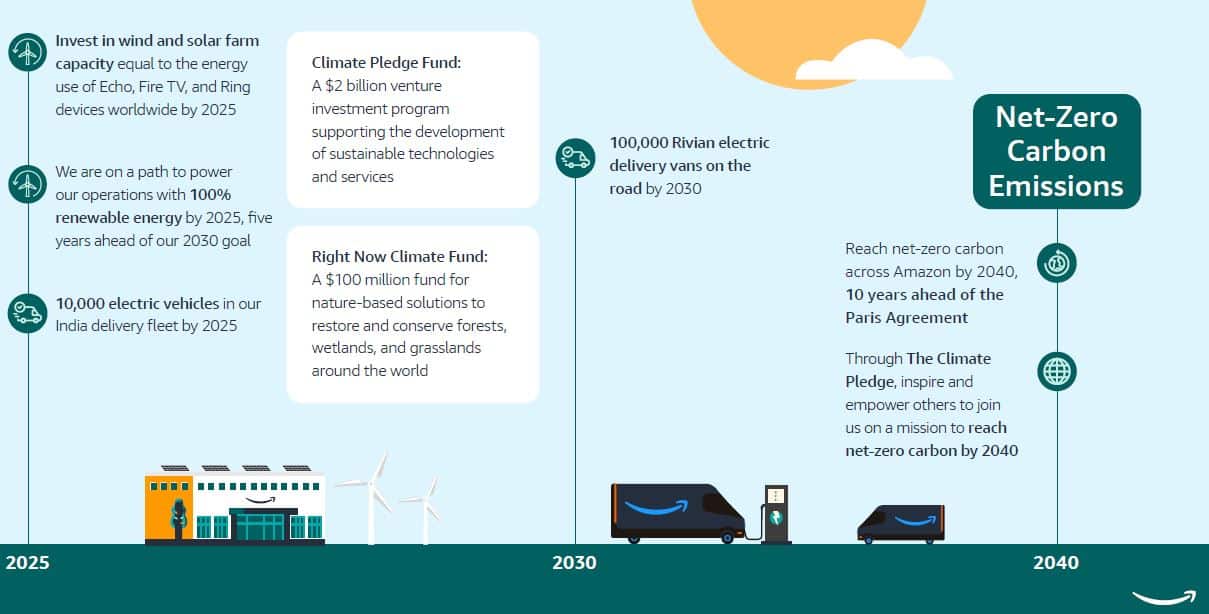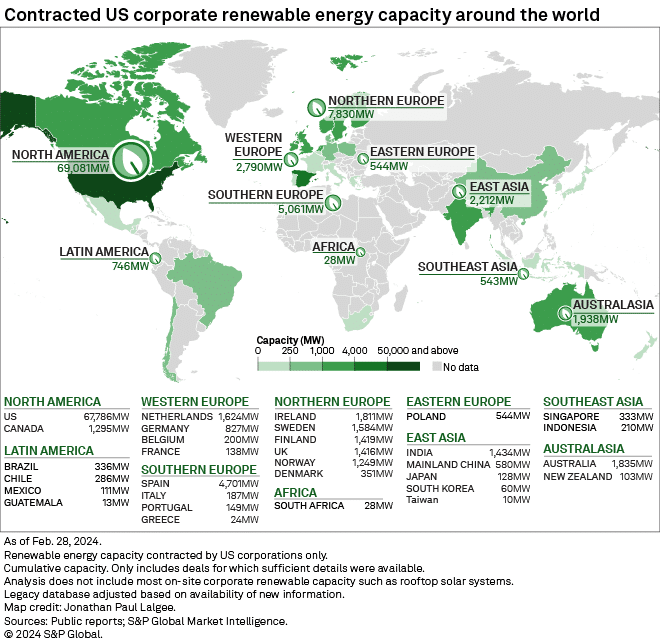In the dynamic landscape of energy transition, US corporations have embarked on a remarkable journey, ramping up renewable energy initiatives. Since March 2023, corporate initiatives have actively pursued renewables procurement, adding 17 GW of carbon-free generation capacity, per S&P Global Commodity Insights.
The Rise of Renewable Giants
Renewable capacity additions accounted for 9.1 GW of the total added capacity since March 2023. Texas led the market, representing 43% of the added capacity. Solar energy dominated the signed capacity, comprising 81% of the capacity added in the US.
Domestic renewable capacity contracted by US-based corporations reached 67.8 GW by February 2024, with Amazon leading the pack. The tech giant accounts for a quarter of the contracted renewable capacity.
On a global scale, US corporations continued to make deals across five continents, with Europe leading in deal activity. Spain emerged as the most popular destination, adding over 2.1 GW of additional corporate capacity in the past 12 months. Half of this is attributed to Amazon, primarily in solar energy projects.
The trend continues to favor utility-scale solar growth, supported by low-cost solar equipment and federal tax credits. Utility-scale solar capacity in development surged by 24% since March 2023, reaching 286 GW, and solar now comprises over 62% of US capacity contracted to American corporations.
Moreover, grid-scale battery storage capacity in development doubled over the last year, reaching nearly 140 GW. Of that, over 50 GW is colocated with wind or solar projects. This integration of battery storage enhances grid flexibility and revenue streams, particularly for intermittent generation sources like solar.
Over 6 GW of battery capacity is currently paired with wind and solar projects that have contracted with non-utility off-takers.
Fueling Renewables Growth Worldwide
Corporate procurement initiatives expanded to encompass 43 US states, with Texas maintaining its dominance as the leading market, constituting 57% of the aggregate corporate renewable capacity tracked by S&P Global Commodity Insights.
Notably, six deals of 200 MW or more were inked with Texas projects since March 2023. Among these, Amazon’s 250-MW agreement with Hecate Energy for the 514-MW Outpost Solar Project stands out. The partnership will potentially include 508 MW of paired battery storage capacity.
California ranked second to Texas in corporate renewable capacity added. Again, this is primarily driven by Amazon’s contracts with AES Corp. for two 500-MW solar projects, totaling 1 GW.
According to a White House report, there’s an announcements of >100 gigawatts (GW) of solar module manufacturing capacity. This can potentially generate enough solar panels to power about 10% of homes in the U.S., representing over $13 billion in investments.
Solar Capacity Projections Over Time

About three-quarters of the tracked corporate renewable capacity contracted internationally by US businesses was concentrated in Europe. Northern Europe particularly stands out due to its top offshore wind speeds, per S&P Global analysis.
In this region, spanning from the British Isles to the Nordics, US companies accumulated 7.8 GW of corporate-tied renewable energy capacity, with wind accounting for 76% of this total.
Meanwhile, the African continent experienced the second largest year-over-year jump, increasing by 180%. This is primarily driven by an additional 18 MW of tracked capacity subscribed to by US commercial entities in South Africa.
Australasia, boasting abundant solar and wind resources, rounded out the top three in terms of year-over-year growth, expanding by almost 125%. Despite the substantial growth, the region’s cumulative capacity approached the 2-GW mark as of February 2024.
Amazon’s Renewable Energy Leadership
Among the renewable contracts signed worldwide, Amazon takes the top spot. The tech giant is the world’s largest corporate purchaser of renewable energy for the 4th year in a row.
In 2023, Amazon made significant strides in its commitment to renewable energy by investing in over 100 new solar and wind energy projects.
With over 500 wind and solar projects globally, Amazon could generate more than 77,000 gigawatt-hours (GWh) of clean energy annually once these projects become operational. This translates to enough clean energy to power around 7.2 million U.S. homes every year.
These projects are propelling Amazon closer to its goal of sourcing 100% of the electricity for its operations from renewable energy sources by 2025. The renewable energy generated by these projects is already being utilized to power various Amazon facilities, including data centers, fulfillment centers, physical stores, and corporate offices. Moreover, these projects contribute to providing clean power to local communities where they operate.
The impact of Amazon’s solar and wind farms extends beyond environmental benefits. They have also catalyzed over $12 billion in estimated economic investment globally from 2014 through 2022.
Amazon Net Zero Roadmap

All these renewables initiatives are part of the retailer’s decarbonization strategy. The company also founded the The Climate Pledge in 2019, which lays out its net zero commitments. Amazon aims to reach net zero by 2040, 10 years ahead of the 2050 goal set by the Paris Agreement.
As the world marches towards a sustainable future, US corporations stand at the forefront, driving change through ambitious renewable energy procurement initiatives. Under Amazon’s renewable leadership, they continue to shape the energy landscape and inspire a global shift towards a sustainable future.


